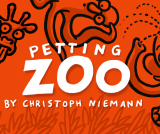
As a former speaker in both 2005 and 2010, renowned graphic designer and Pentagram partner Michael Bierut has also served as one of Design Indaba's masterful emcees for the past three years. Each day, wearing a shirt and tie matching his cheerful demeanor, he enthusiastically presents the impressive roster of speakers, adding valuable industry insight and witty commentary between presentations. With Cape Town named the World Design Capital for 2014, we checked in with Bierut to hear more about how the Conference On Creativity and the city itself have evolved over the years.
You've been a moderator for three years now, how did you initially get involved with Design Indaba?
I was invited several times to present at Design Indaba, but I was never able to go because it almost always conflicted with my daughter Martha's birthday. Finally, I was able to go in 2005, but I did it as a quick in-and-out. This works for some conferences, but at Indaba, it's a terrible idea. Everyone, including the speakers, should come early and leave late. Doing it any other way misses the point.
I stayed in touch with organizer Ravi Naidoo after my first visit and I was invited back to speak in 2010. On my second visit, he asked if I could also help out by serving as a co-emcee. I had fun, came early and stayed late, and he's asked me to come back in the same role in the two years since.
How have you seen the conference grow since then?
Obviously, the attendance at both the conference and the expo have grown dramatically, with simulcast audiences joining in from Johannesburg, Durban, and elsewhere in Cape Town. More importantly it's grown from being a design conference for insiders to being a galvanizing event for Cape Town and for South Aftrica that's all about the power of creativity and design.
What are some key moments or speakers that have stood out over the years?
I remember Dieter Rams at the conference in 2005 preaching his less is more aesthetic with precision and passion. Two years ago, I was knocked out by architect Alejandro Aravena: his is the only presentation I've ever seen where 15 seconds in I started frantically transcribing what was on every single slide. Last year, Francis Kere from Burkina Faso brought the house down with a presentation that showed how socially responsible practice could support great, beautiful design.
Every year, some of the best presentations are from students. Cape Town fashion designer Laduma Ngxokolo did a line of clothing inspired by African patterns that I still desperately want in my closet. And RCA industrial design student Thomas Thwaites showed a project where he made a toaster by hand from raw materials he found himself. The story was so sharp and funny that I asked for a copy of his thesis presentation and gave it to Kevin Lippert at Princeton Architectural Press. He published it last year, and a month or so ago, Thomas was promoting it on the Colbert Report! It all starts at Design Indaba.
I always come away feeling uniquely inspired after the conference, how do you feel after the entire experience each year?
Indaba is remarkable in that it brings together people from every creative discipline from every part of world to share ideas. People come eager to hear from the superstars, but over and over again, it's someone you've never heard of who blows you away.
What do you think the audience at large takes away from the conference?
I think the conference brings out the best in the speakers. You feel the energy from the audience, and the people on stage really feel an obligation to make a connection. The audience can really sense this, and as a result they come way feeling that they did just sit there and witness it, but they actually participated in it. It's active, not passive.
Do you feel Design Indaba has had a hand in helping Cape Town become the Design Capital for 2014?
I suspect it may be Cape Town's best argument as to why it deserves to be the World Design Capital.
How does a conference like Design Indaba foster creativity in the long run?
Creativity doesn't happen in a vacuum. It's all about connections. Design Indaba makes connections that last, and those connections have the capacity to change the world.













